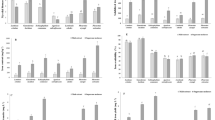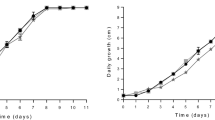Abstract
Edible basidiomycetesFlammulia velutipes andPleurotus ostreatus were cultivated in the usual manner on media based on sawdust and rice bran, and the cultures were exposed to slowly flowing CO2-enriched air (550 (control), 3,000, 6,000, and 9,000µl/l) for seven days at different stages of cultivation. When the cultures were exposed at the primordium stage (less than 10 mm in length), length and yield of fruit-bodies increased and pileus expansion was slightly inhibited inF. velutipes, while inP. ostreatus length increased, yield decreased, and pileus expansion was greatly inhibited. When the cultures with fruit-bodies larger than 10 mm were exposed, length and yield were insensitive and pileus expansion was greatly inhibited inF. velutipes, while inP. ostreatus length was insensitive, but pileus expansion was heavily damaged by trumpet-like deformation and yield decreased. The different action of CO2 on the two species appeared to be due to the different anatomical structures of their fruit-bodies.
Similar content being viewed by others
Literature cited
Aiga, I., Omasa, K. and Abo, F. 1978. Growth cabinet for air pollutions gas fumigation. Res. Rep. Natl. Inst. Environ. Stud., No. 2 pp. 193–209 (in Japanese).
Gruen, H. E. 1969. Growth and rotation ofFlammulina velutipes fruit-bodies and the dependence of stipe elongation on the cap. Mycologia61: 149–166.
Hagimoto, H. 1964. On the growth of the fruit body ofAgaricus bisporus (Lange) Sing. Trans. Mycol. Soc. Japan4: 158–164.
Hagimoto, H. and Konishi, M. 1959. Studies on the growth of fruit-bodies of fungi. Existence of a hormone active to the growth of fruit-body inAgaricus bisporus (Lange) Sing. Bot. Mag. (Tokyo)72: 359–366.
Hagimoto, H. and Konishi, M. 1960. Studies on the growth of fruit-bodies of fungi II. Activity and stability of the growth hormone in the fruit-body ofAgaricus bisporus (Lange) Sing. Bot. Mag. (Tokyo)73: 283–287.
Hintikka, V. 1982. The colonization of litter and wood by basidiomycetes in Finish forests. In: “Decomposer basidiomycetes,” (ed. by Frankland, J. C. et al.), pp. 227–239. Cambridge Univ. Press, London.
Ingold, C. T. and Nawaz, N. 1967. Carbon dioxide and fruiting inSphaerobolus. Ann. Bot. [N. S.]31: 351–356.
Kinugawa, K., Takamatsu, Y., Suzuki, A., Tanaka, K. and Kondo, N. 1986. Effect of concentrated carbon dioxide on the fruiting of several cultivated basidiomycetes. Trans. Mycol. Soc. Japan27: 327–340.
Lambert, E. B. 1933. Effect of excess carbon dioxide on growing mushrooms. J. Agric. Res.47: 599–608.
Long, P. E. 1966. Carbon dioxide effect in the mushroomCollybia velutipes. Mycologia53: 319–322.
Long, P. E. and Jacobs, L. 1974. Aseptic fruiting of the cultivated mushroom,Agaricus bisporus. Trans. Br. Mycol. Soc.63: 99–107.
McLaughlin, D. J. 1970. Environmental control of fruit-body development inBoletus rubinellus in axenic culture. Mycologia62: 307–331.
Niederpruem, D. J. 1963. Role of carbon dioxide in the control of fruiting ofSchizophyllum commune. J. Bact.85: 1300–1308.
Plunkett, B. E. 1956. The influence of factors of the aeration complex and light upon fruit-body form in pure cultures of an agaric and a polypore. Ann. Bot. [N. S.]20: 563–586.
Schwalb, M. N. 1971. Commitment to fruiting in synchronously developing cultures of the basidiomyceteSchizophyllum commune. Arch. Mikrobiol.79: 102–107.
Schwantes, H. R. O. and Hagemann, F. 1965. Untersuchungen zur Fruchtkörperbildung beiLentinus tigrinus Bull. Ber. Deut. Bot. Ges.78: 80–101.
Sietsma, J. H., Rast, D. and Wessels, J. G. H. 1977. The effect of carbon dioxide on fruiting and on the degradation of a cell-wall glucan inSchizophyllum commun. J. Gen. Microbiol.102: 385–389.
Tschierpe, H. J. and Sinden, J. W. 1964. Weitere Untersuchungen über die Bedeutung von Kohlendioxyd für die Fruktifikation des Kulturchampignons,Agaricus campestris var.bisporus (L) Lange. Arch. Mikrobiol.49: 405–425.
Zadražil, F. 1978. Cultivation ofPleurotus. In: “The biology and cultivation of edible mushrooms,” (ed. by Chang, S. T. and Hayes, W. A.), pp. 521–557. Academic Press, New York.
Author information
Authors and Affiliations
About this article
Cite this article
Kinugawa, K., Suzuki, A., Takamatsu, Y. et al. Effects of concentrated carbon dioxide on the fruiting of several cultivated basidiomycetes (II). Mycoscience 35, 345–352 (1994). https://doi.org/10.1007/BF02268504
Accepted:
Issue Date:
DOI: https://doi.org/10.1007/BF02268504




